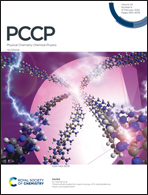Dehydrogenation of ammonia–borane to functionalize neutral and Li+-encapsulated C60, C70 and C36 fullerene cages: a DFT approach†
Abstract
Mechanistic investigations into the functionalization of three fullerene cages, viz. C60, C70, and C36 through dehydrogenation of ammonia–borane (AB) have been conducted using Density Functional Theory (DFT). In this process of functionalization, different ring fusions, namely (6-6), (6-5) positions for C60 and C70, and an additional (5-5) for C36 fullerene have been investigated. The optimized geometries of all the complexes and transition states have been characterized using the M06-2X functional in conjunction with the 6-31G(d) basis set. The effect of Li+-encapsulation on the energetics and activation barriers of H2 attachment has also been examined. Although the process of functionalization of neutral fullerenes proceeds extensively through concerted pathways, a step-wise route has been observed for the encapsulated systems. NPA charge analysis and Wiberg bond index (WBI) have been used in order to detect the change in the nature of participating hydrogen atoms and validate the variation in the bond order of the C–C connectivity respectively upon hydrogenation. GCRD parameters have also been calculated to explicate the electronic properties of the hydrogenated products. The (6-6) hydrogenation is observed to be favoured thermodynamically and kinetically for both neutral and Li+-encapsulated C60 and C70, while (5-5) is found to be the most preferred site for C36 systems. Our theoretical exploration suggests that the covalent functionalization of the fullerene cages can be done successfully viaAB resulting in the stabilization of these systems. In short, the present work will provide a general idea about the detailed mechanism related to the functionalization of fullerene cages, which will further motivate researchers in fullerene chemistry.



 Please wait while we load your content...
Please wait while we load your content...